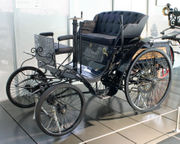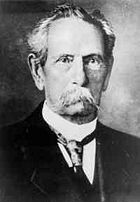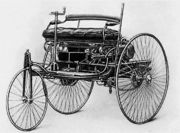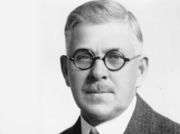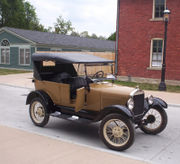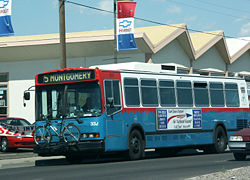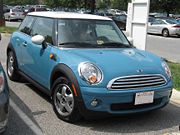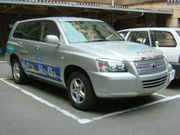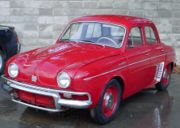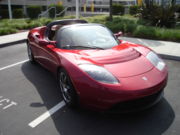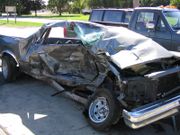Automobile
2008/9 Schools Wikipedia Selection. Related subjects: Road transport
An automobile or motor car is a wheeled motor vehicle for transporting passengers; which also carries its own engine or motor. Most definitions of the term specify that automobiles are designed to run primarily on roads, to have seating for one to eight people, to typically have four wheels, and to be constructed principally for the transport of people rather than goods. However, the term is far from precise because there are many types of vehicles that do similar tasks.
Automobile comes via the French language, from the Greek language by combining auto [self] with mobilis [moving]; meaning a vehicle that moves itself, rather than being pulled or pushed by a separate animal or another vehicle. The alternative name car is believed to originate from the Latin word carrus or carrum [wheeled vehicle], or the Middle English word carre [ cart] (from Old North French), and karros; a Gallic wagon.
As of 2002, there were 590 million passenger cars worldwide (roughly one car per eleven people).
History
Although Nicolas-Joseph Cugnot is often credited with building the first self-propelled mechanical vehicle or automobile in about 1769 by adapting an existing horse-drawn vehicle, this claim is disputed by some, who doubt Cugnot's three-wheeler ever ran or was stable. Others claim Ferdinand Verbiest, a member of a Jesuit mission in China, built the first steam-powered vehicle around 1672 which was of small scale and designed as a toy for the Chinese Emperor that was unable to carry a driver or a passenger, but quite possibly, was the first working steam-powered vehicle ('auto-mobile'). What is not in doubt is that Richard Trevithick built and demonstrated his Puffing Devil road locomotive in 1801, believed by many to be the first demonstration of a steam-powered road vehicle although it was unable to maintain sufficient steam pressure for long periods, and would have been of little practical use.
In Russia in the 1780s Ivan Kulibin started working on a human-pedalled carriage with s steam engine. He finished working on it in 1791. Some of its features included a flywheel, brake, gear box, and bearing, which are also the features of a modern automobile. His design had three wheels. Unfortunately, like for many of his inventions, the government failed to see the potential market and it was not developed further.
François Isaac de Rivaz, a Swiss inventor, designed the first internal combustion engine, in 1806, which was fueled by a mixture of hydrogen and oxygen and used it to develop the world's first vehicle, albeit rudimentary, to be powered by such an engine. The design was not very successful, as was the case with those of Samuel Brown, Samuel Morey, and Etienne Lenoir who each produced vehicles (adapted carriages, carts, or boats) powered by clumsy internal combustion engines.
In November 1881 French inventor Gustave Trouvé demonstrated a working three-wheeled automobile that was powered by electricity. This was at the International Exhibition of Electricity in Paris.
Although several other German engineers (including Gottlieb Daimler, Wilhelm Maybach, and Siegfried Marcus) were working on the problem at about the same time, Karl Benz generally is acknowledged as the inventor of the modern automobile.
An automobile powered by his own four-stroke cycle gasoline engine was built in Mannheim, Germany by Karl Benz in 1885 and granted a patent in January of the following year under the auspices of his major company, Benz & Cie., which was founded in 1883. It was an integral design, without the adaptation of other existing components and including several new technological elements to create a new concept. This is what made it worthy of a patent. He began to sell his production vehicles in 1888.
In 1879 Benz was granted a patent for his first engine, which had been designed in 1878. Many of his other inventions made the use of the internal combustion engine feasible for powering a vehicle.
His first Motorwagon was built in 1885 and he was awarded the patent for its invention as of his application on January 29, 1886. Benz began promotion of the vehicle on July 3, 1886 and approximately 25 Benz vehicles were sold between 1888 and 1893, when his first four-wheeler was introduced along with a model intended for affordability. They also were powered with four-stroke engines of his own design. Emile Roger of France, already producing Benz engines under license, now added the Benz automobile to his line of products. Because France was more open to the early automobiles, initially more were built and sold in France through Roger than Benz sold in Germany.
In 1896, Benz designed and patented the first internal-combustion flat engine, called a boxermotor in German. During the last years of the nineteenth century, Benz was the largest automobile company in the world with 572 units produced in 1899 and because of its size, Benz & Cie., became a joint-stock company.
Daimler and Maybach founded Daimler Motoren Gesellschaft (Daimler Motor Company, DMG) in Cannstatt in 1890 and under the brand name, Daimler, sold their first automobile in 1892, which was a horse-drawn stagecoach built by another manufacturer, that they retrofitted with an engine of their design. By 1895 about 30 vehicles had been built by Daimler and Maybach, either at the Daimler works or in the Hotel Hermann, where they set up shop after falling out with their backers. Benz and the Maybach and Daimler team seem to have been unaware of each other's early work. They never worked together because by the time of the merger of the two companies, Daimler and Maybach were no longer part of DMG.
Daimler died in 1900 and later that year, Maybach designed an engine named Daimler-Mercedes, that was placed in a specially-ordered model built to specifications set by Emil Jellinek. This was a production of a small number of vehicles for Jellinek to race and market in his country. Two years later, in 1902, a new model DMG automobile was produced and the model was named Mercedes after the Maybach engine which generated 35 hp. Maybach quit DMG shortly thereafter and opened a business of his own. Rights to the Daimler brand name were sold to other manufacturers.
Karl Benz proposed co-operation between DMG and Benz & Cie. when economic conditions began to deteriorate in Germany following the First World War, but the directors of DMG refused to consider it initially. Negotiations between the two companies resumed several years later when these conditions worsened and, in 1924 they signed an Agreement of Mutual Interest, valid until the year 2000. Both enterprises standardized design, production, purchasing, and sales and they advertised or marketed their automobile models jointly—although keeping their respective brands.
On June 28, 1926, Benz & Cie. and DMG finally merged as the Daimler-Benz company, baptizing all of its automobiles Mercedes Benz as a brand honoring the most important model of the DMG automobiles, the Maybach design later referred to as the 1902 Mercedes-35hp, along with the Benz name. Karl Benz remained a member of the board of directors of Daimler-Benz until his death in 1929 and at times, his two sons participated in the management of the company as well.
In 1890, Emile Levassor and Armand Peugeot of France began producing vehicles with Daimler engines and so laid the foundation of the automobile industry in France.
The first design for an American automobile with a gasoline internal combustion engine was drawn in 1877 by George Selden of Rochester, New York, who applied for a patent for an automobile in 1879, but the patent application expired because the vehicle was never built and proved to work (a requirement for a patent). After a delay of sixteen years and a series of attachments to his application, on November 5, 1895, Selden was granted a United States patent () for a two-stroke automobile engine, which hindered, more than encouraged, development of automobiles in the United States. His patent was challenged by Henry Ford and others, and overturned in 1911.
In Britain there had been several attempts to build steam cars with varying degrees of success with Thomas Rickett even attempting a production run in 1860. Santler from Malvern is recognized by the Veteran Car Club of Great Britain as having made the first petrol-powered car in the country in 1894 followed by Frederick William Lanchester in 1895 but these were both one-offs. The first production vehicles in Great Britain came from the Daimler Motor Company, a company founded by Harry J. Lawson in 1896 after purchasing the right to use the name of the engines. Lawson's company made its first automobiles in 1897 and they bore the name Daimler.
In 1892, German engineer Rudolf Diesel was granted a patent for a "New Rational Combustion Engine". In 1897 he built the first Diesel Engine. Steam-, electric-, and gasoline-powered vehicles competed for decades, with gasoline internal combustion engines achieving dominance in the 1910s.
Although various pistonless rotary engine designs have attempted to compete with the conventional piston and crankshaft design, only Mazda's version of the Wankel engine has had more than very limited success.
Production
The large-scale, production-line manufacturing of affordable automobiles was debuted by Ransom Olds at his Oldsmobile factory in 1902. This concept was greatly expanded by Henry Ford, beginning in 1914.
As a result, Ford's cars came off the line in fifteen minute intervals, much faster than previous methods, increasing production by seven to one (requiring 12.5 man-hours before, 1 hour 33 minutes after), while using less manpower. It was so successful, paint became a bottleneck. Only Japan black would dry fast enough, forcing the company to drop the variety of colors available before 1914, until fast-drying Duco lacquer was developed in 1926. This is the source of Ford's apocryphal remark, "any colour as long as it's black". In 1914, an assembly line worker could buy a Model T with four months' pay.

Ford's complex safety procedures—especially assigning each worker to a specific location instead of allowing them to roam about—dramatically reduced the rate of injury. The combination of high wages and high efficiency is called " Fordism," and was copied by most major industries. The efficiency gains from the assembly line also coincided with the economic rise of the United States. The assembly line forced workers to work at a certain pace with very repetitive motions which led to more output per worker while other countries were using less productive methods.
In the automotive industry, its success was dominating, and quickly spread worldwide seeing the founding of Ford France and Ford Britain in 1911, Ford Denmark 1923, Ford Germany 1925; in 1921, Citroen was the first native European manufacturer to adopt the production method. Soon, companies had to have assembly lines, or risk going broke; by 1930, 250 companies which did not, had disappeared.
Development of automotive technology was rapid, due in part to the hundreds of small manufacturers competing to gain the world's attention. Key developments included electric ignition and the electric self-starter (both by Charles Kettering, for the Cadillac Motor Company in 1910-1911), independent suspension, and four-wheel brakes.
Since the 1920s, nearly all cars have been mass-produced to meet market needs, so marketing plans often have heavily influenced automobile design. It was Alfred P. Sloan who established the idea of different makes of cars produced by one company, so buyers could "move up" as their fortunes improved.
Reflecting the rapid pace of change, makes shared parts with one another so larger production volume resulted in lower costs for each price range. For example, in the 1930s, LaSalles, sold by Cadillac, used cheaper mechanical parts made by Oldsmobile; in the 1950s, Chevrolet shared hood, doors, roof, and windows with Pontiac; by the 1990s, corporate drivetrains and shared platforms (with interchangeable brakes, suspension, and other parts) were common. Even so, only major makers could afford high costs, and even companies with decades of production, such as Apperson, Cole, Dorris, Haynes, or Premier, could not manage: of some two hundred American car makers in existence in 1920, only 43 survived in 1930, and with the Great Depression, by 1940, only 17 of those were left.
In Europe much the same would happen. Morris set up its production line at Cowley in 1924, and soon outsold Ford, while beginning in 1923 to follow Ford's practise of vertical integration, buying Hotchkiss (engines), Wrigley (gearboxes), and Osberton (radiators), for instance, as well as competitors, such as Wolseley: in 1925, Morris had 41% of total British car production. Most British small-car assemblers, from Abbey to Xtra had gone under. Citroen did the same in France, coming to cars in 1919; between them and other cheap cars in reply such as Renault's 10CV and Peugeot's 5CV, they produced 550,000 cars in 1925, and Mors, Hurtu, and others could not compete. Germany's first mass-manufactured car, the Opel 4PS Laubfrosch (Tree Frog), came off the line at Russelsheim in 1924, soon making Opel the top car builder in Germany, with 37.5% of the market.
Fuel and propulsion technologies
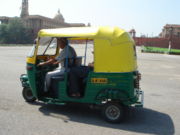
Most automobiles in use today are propelled by gasoline (also known as petrol) or diesel internal combustion engines, which are known to cause air pollution and are also blamed for contributing to climate change and global warming. Increasing costs of oil-based fuels, tightening environmental laws and restrictions on greenhouse gas emissions are propelling work on alternative power systems for automobiles. Efforts to improve or replace existing technologies include the development of hybrid vehicles, and electric and hydrogen vehicles which do not release pollution into the air.
Diesel
Diesel-engined cars have long been popular in Europe with the first models being introduced in the 1930s by Mercedes Benz and Citroen. The main benefit of diesel engines is a 50% fuel burn efficiency compared with 27% in the best gasoline engines. A down-side of the diesel is the presence in the exhaust gases of fine soot particulates and manufacturers are now starting to fit filters to remove these. Many diesel-powered cars can also run with little or no modifications on 100% biodiesel.
Gasoline
Gasoline engines have the advantage over diesel in being lighter and able to work at higher rotational speeds and they are the usual choice for fitting in high-performance sports cars. Continuous development of gasoline engines for over a hundred years has produced improvements in efficiency and reduced pollution. The carburetor was used on nearly all road car engines until the 1980s but it was long realised better control of the fuel/air mixture could be achieved with fuel injection. Indirect fuel injection was first used in aircraft engines from 1909, in racing car engines from the 1930s, and road cars from the late 1950s. Gasoline Direct Injection (GDI) is now starting to appear in production vehicles such as the 2007 (Mark II) BMW Mini. Exhaust gases are also cleaned up by fitting a catalytic converter into the exhaust system. Clean air legislation in many of the car industries most important markets has made both catalysts and fuel injection virtually universal fittings. Most modern gasoline engines also are capable of running with up to 15% ethanol mixed into the gasoline - older vehicles may have seals and hoses that can be harmed by ethanol. With a small amount of redesign, gasoline-powered vehicles can run on ethanol concentrations as high as 85%. 100% ethanol is used in some parts of the world (such as Brazil), but vehicles must be started on pure gasoline and switched over to ethanol once the engine is running. Most gasoline engined cars can also run on LPG with the addition of an LPG tank for fuel storage and carburetion modifications to add an LPG mixer. LPG produces fewer toxic emissions and is a popular fuel for fork lift trucks that have to operate inside buildings.
Bioalcohols and biogasoline
Ethanol, other alcohol fuels ( biobutanol) and biogasoline have widespread use an automotive fuel. Most alcohols have less energy per liter than gasoline and are usually blended with gasoline. Alcohols are used for a variety of reasons - to increase octane, to improve emissions, and as an alternative to petroleum based fuel, since they can be made from agricultural crops. Brazil's ethanol program provides about 20% of the nations automotive fuel needs, including several million cars that operate on pure ethanol.
Electric
The first electric cars were built around 1832, well before internal combustion powered cars appeared. For a period of time electrics were considered superior due to the silent nature of electric motors compared to the very loud noise of the gasoline engine. This advantage was removed with Hiram Percy Maxim's invention of the muffler in 1897. Thereafter internal combustion powered cars had two critical advantages: 1) long range and 2) high specific energy (far lower weight of petrol fuel versus weight of batteries). The building of battery electric vehicles that could rival internal combustion models had to wait for the introduction of modern semiconductor controls and improved batteries. Because they can deliver a high torque at low revolutions electric cars do not require such a complex drive train and transmission as internal combustion powered cars. Some post-2000 electric car designs such as the Venturi Fétish are able to accelerate from 0-60 mph (96 km/h) in 4.0 seconds with a top speed around 130 mph (210 km/h). Others have a range of 250 miles (400 km) on the EPA highway cycle requiring 3-1/2 hours to completely charge. Equivalent fuel efficiency to internal combustion is not well defined but some press reports give it at around 135 mpg–U.S. (1.74 L/100 km / 162.1 mpg–imp).
Steam
Steam power, usually using an oil- or gas-heated boiler, was also in use until the 1930s but had the major disadvantage of being unable to power the car until boiler pressure was available (although the newer models could achieve this in well under a minute). It has the advantage of being able to produce very low emissions as the combustion process can be carefully controlled. Its disadvantages include poor heat efficiency and extensive requirements for electric auxiliaries.
Air
A compressed air car is an alternative fuel car that uses a motor powered by compressed air. The car can be powered solely by air, or by air combined (as in a hybrid electric vehicle) with gasoline/diesel/ethanol or electric plant and regenerative braking. Instead of mixing fuel with air and burning it to drive pistons with hot expanding gases; compressed air cars use the expansion of compressed air to drive their pistons. Several prototypes are available already and scheduled for worldwide sale by the end of 2008. Companies releasing this type of car include Tata Motors and Motor Development International (MDI).
Gas turbine
In the 1950s there was a brief interest in using gas turbine (jet) engines and several makers including Rover and Chrysler produced prototypes. In spite of the power units being very compact, high fuel consumption, severe delay in throttle response, and lack of engine braking meant no cars reached production.
Rotary (Wankel) engines
Rotary Wankel engines were introduced into road cars by NSU with the Ro 80 and later were seen in the Citroën GS Birotor and several Mazda models. In spite of their impressive smoothness, poor reliability and fuel economy led to them largely disappearing. Mazda, beginning with the R100 then RX-2, has continued research on these engines, overcoming most of the earlier problems with the RX-7 and RX-8.
Rocket and jet cars
A rocket car holds the record in drag racing. However, the fastest of those cars are used to set the Land Speed Record, and are propelled by propulsive jets emitted from rocket, turbojet, or more recently and most successfully turbofan engines. The ThrustSSC car using two Rolls-Royce Spey turbofans with reheat was able to exceed the speed of sound at ground level in 1997.
Safety
Road traffic injuries represent about 25% of worldwide injury-related deaths (the leading cause) with an estimated 1.2 million deaths (2004) each year.
Automobile accidents are almost as old as automobiles themselves. Early examples include Mary Ward, who became one of the first documented automobile fatalities in 1869 in Parsonstown, Ireland, and Henry Bliss, one of the United State's first pedestrian automobile casualties in 1899 in New York.
Cars have many basic safety problems - for example, they have human drivers who can make mistakes, wheels that can lose traction when braking, turning or acceleration forces are too high, and mechanical systems subject to failure. Collisions can have very serious or fatal consequences. Some vehicles have a high centre of gravity and therefore an increased tendency to roll over.
Early safety research focused on increasing the reliability of brakes and reducing the flammability of fuel systems. For example, modern engine compartments are open at the bottom so that fuel vapors, which are heavier than air, vent to the open air. Brakes are hydraulic and dual circuit so that a total braking failure is very rare. Systematic research on crash safety started in 1958 at Ford Motor Company. Since then, most research has focused on absorbing external crash energy with crushable panels and reducing the motion of human bodies in the passenger compartment. This is reflected in most cars produced today.
Significant reductions in death and injury have come from the addition of Safety belts and laws in many countries to require vehicle occupants to wear them. Airbags and specialised child restraint systems have improved on that. Structural changes such as side-impact protection bars in the doors and side panels of the car mitigate the effect of impacts to the side of the vehicle. Many cars now include radar or sonar detectors mounted to the rear of the car to warn the driver if he or she is about to reverse into an obstacle or a pedestrian. Some vehicle manufacturers are producing cars with devices that also measure the proximity to obstacles and other vehicles in front of the car and are using these to apply the brakes when a collision is inevitable. There have also been limited efforts to use heads up displays and thermal imaging technologies similar to those used in military aircraft to provide the driver with a better view of the road at night.
There are standard tests for safety in new automobiles, like the EuroNCAP and the US NCAP tests. There are also tests run by organizations such as IIHS and backed by the insurance industry.
Despite technological advances, there is still significant loss of life from car accidents: About 40,000 people die every year in the United States, with similar figures in European nations. This figure increases annually in step with rising population and increasing travel if no measures are taken, but the rate per capita and per mile traveled decreases steadily. The death toll is expected to nearly double worldwide by 2020. A much higher number of accidents result in injury or permanent disability. The highest accident figures are reported in China and India. The European Union has a rigid program to cut the death toll in half by 2010, and member states have started implementing measures.
Automated control has been seriously proposed and successfully prototyped. Shoulder-belted passengers could tolerate a 32 g emergency stop (reducing the safe inter-vehicle gap 64-fold) if high-speed roads incorporated a steel rail for emergency braking. Both safety modifications of the roadway are thought to be too expensive by most funding authorities, although these modifications could dramatically increase the number of vehicles able to safely use a high-speed highway. This makes clear the often-ignored fact road design and traffic control also play a part in car wrecks; unclear traffic signs, inadequate signal light placing, and poor planning (curved bridge approaches which become icy in winter, for example), also contribute.
Economics and impacts
Cost and benefits of usage
The costs of automobile usage, which may include the cost of: acquiring the vehicle, repairs, maintenance, fuel, depreciation, parking fees, tire replacement, taxes and insurance, are weighed against the cost of the alternatives, and the value of the benefits - perceived and real - of vehicle usage. The benefits may include on-demand transportation, mobility, independence and convenience.
Cost and benefits to society
Similarly the costs to society of encompassing automobile use, which may include those of: maintaining roads, land use, pollution, public health, health care, and of disposing of the vehicle at the end of its life, can be balanced against the value of the benefits to society that automobile use generates. The societal benefits may include: economy benefits, such as job and wealth creation, of automobile production and maintenance, transportation provision, society wellbeing derived from leisure and travel opportunities, and revenue generation from the tax opportunities. The ability for humans to move flexibly from place to place has far reaching implications for the nature of societies.
Impacts on society and environment
Transportation is a major contributor to air pollution in most industrialised nations. According to the American Surface Transportation Policy Project nearly half of all Americans are breathing unhealthy air. Their study showed air quality in dozens of metropolitan areas has got worse over the last decade. In the United States the average passenger car emits 11,450 lbs (5 tonnes) of carbon dioxide, along with smaller amounts of carbon monoxide, hydrocarbons, and nitrogen. Residents of low-density, residential-only sprawling communities are also more likely to die in car collisions, which kill 1.2 million people worldwide each year, and injure about forty times this number. Sprawl is more broadly a factor in inactivity and obesity, which in turn can lead to increased risk of a variety of diseases.
Improving the positive and reducing the negative impacts
Fuel taxes may act as an incentive for the production of more efficient, hence less polluting, car designs (e.g. hybrid vehicles) and the development of alternative fuels. High fuel taxes may provide a strong incentive for consumers to purchase lighter, smaller, more fuel-efficient cars, or to not drive. On average, today's automobiles are about 75 percent recyclable, and using recycled steel helps reduce energy use and pollution. In the United States Congress, federally mandated fuel efficiency standards have been debated regularly, passenger car standards have not risen above the 27.5 mpg–U.S. (8.55 L/100 km / 33 mpg–imp) standard set in 1985. Light truck standards have changed more frequently, and were set at 22.2 mpg–U.S. (10.6 L/100 km / 26.7 mpg–imp) in 2007. Alternative fuel vehicles are another option that is less polluting than conventional petroleum powered vehicles.
Future car technologies
Automobile propulsion technology under development include gasoline/electric and plug-in hybrids, battery electric vehicles, hydrogen cars, biofuels, and various alternative fuels.
Research into future alternative forms of power include the development of fuel cells, Homogeneous Charge Compression Ignition (HCCI), stirling engines, and even using the stored energy of compressed air or liquid nitrogen.
New materials which may replace steel car bodies include duraluminum, fibreglass, carbon fibre, and carbon nanotubes.
Telematics technology is allowing more and more people to share cars, on a pay-as-you-go basis, through such schemes as City Car Club in the UK, Mobility in mainland Europe, and Zipcar in the US.
Alternatives to the automobile
Established alternatives for some aspects of automobile use include public transit ( buses, trolleybuses, trains, subways, monorails, tramways), cycling, walking, rollerblading, skateboarding and using a velomobile. Car-share arrangements and carpooling are also increasingly popular–the U.S. market leader in car-sharing has experienced double-digit growth in revenue and membership growth between 2006 and 2007, offering a service that enables urban residents to "share" a vehicle rather than own a car in already congested neighborhoods. Bike-share systems have been tried in some European cities, including Copenhagen and Amsterdam. Similar programs have been experimented with in a number of U.S. Cities. Additional individual modes of transport, such as personal rapid transit could serve as an alternative to automobiles if they prove to be socially accepted.
